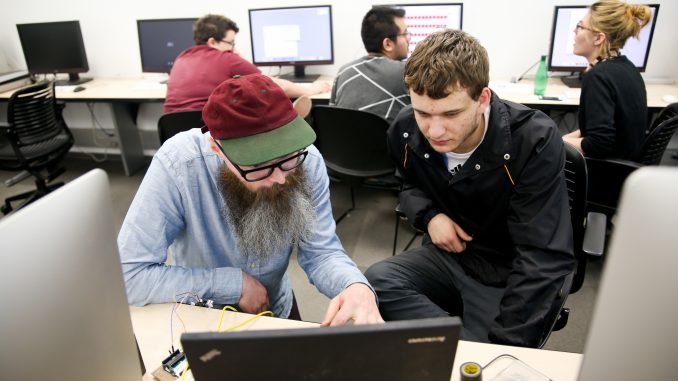
Jacob Christopher Hammes, a Tyler School of Art instructor, thinks there are three approaches to understanding the relationship between art and sound: art history, technical demonstration and conceptualization.
Hammes is one of a few artists in the Tyler School of Art who use sound and music in artwork.
He utilizes sound when he teaches Sound as Sculpture, an art class about “what sound is” and how music and art are related.
For one assignment, Hammes makes his students think about an instrument as a non-musical sculpture. Hammes said the instrument requires interaction with a person in a specific moment in time to become musical.
Hammes studied sound at the Art Institute of Chicago in the early 2000s and made weekly live broadcasts on his music radio show.
The show lasted two years, and then he started working with sculpture. Eventually, he merged his two interests.
In 2013, Hammes began to pursue his master’s in sculpture at Temple. He worked with sound in different capacities, including film and video and completed his degree in 2015.
In class, Hammes tells his students to use their voices as their medium by experimenting with live performance and poetry. He teaches his students recording techniques and made a soundproof booth in the sculpture department for students to record their projects.
“I even get into the physics of sound, and I don’t think anyone was expecting that,” Hammes said.
In addition to the technical demonstration of sound, Hammes stresses that art history is important and that it’s not something to be scared of.
“When I was younger, I think I was afraid of what other artists were doing, thinking ‘if I know this expanding field, and come up with an idea that’s already been done, I won’t be compelled to do it,”’ Hammes said.
C. T. Jasper, a sculpture professor, explores sound through his visual work, similar to Hammes.
In Jasper’s introductory sculpture class, junior sculpture major Princeton Cange had his first opportunity to use sound in an art project that dealt with the concept of time.
“I don’t think that music and art are separate entities,” Cange said. “Art not only encompasses visual compositions, but musical and auditory ones as well.”
Cange said he loves that music has the ability to convey feeling and express a wide range of deep emotions that may have a profound effect on the listener.
“Music and art are both a process of discovering how to tap into ideas, emotions, and ways of thinking,” Hammes said. “I am interested in ideas that take you to a certain place and don’t tell you what to think, but a path of how to think.”
Madison Hall can be reached at madison.hall@temple.edu.


Be the first to comment